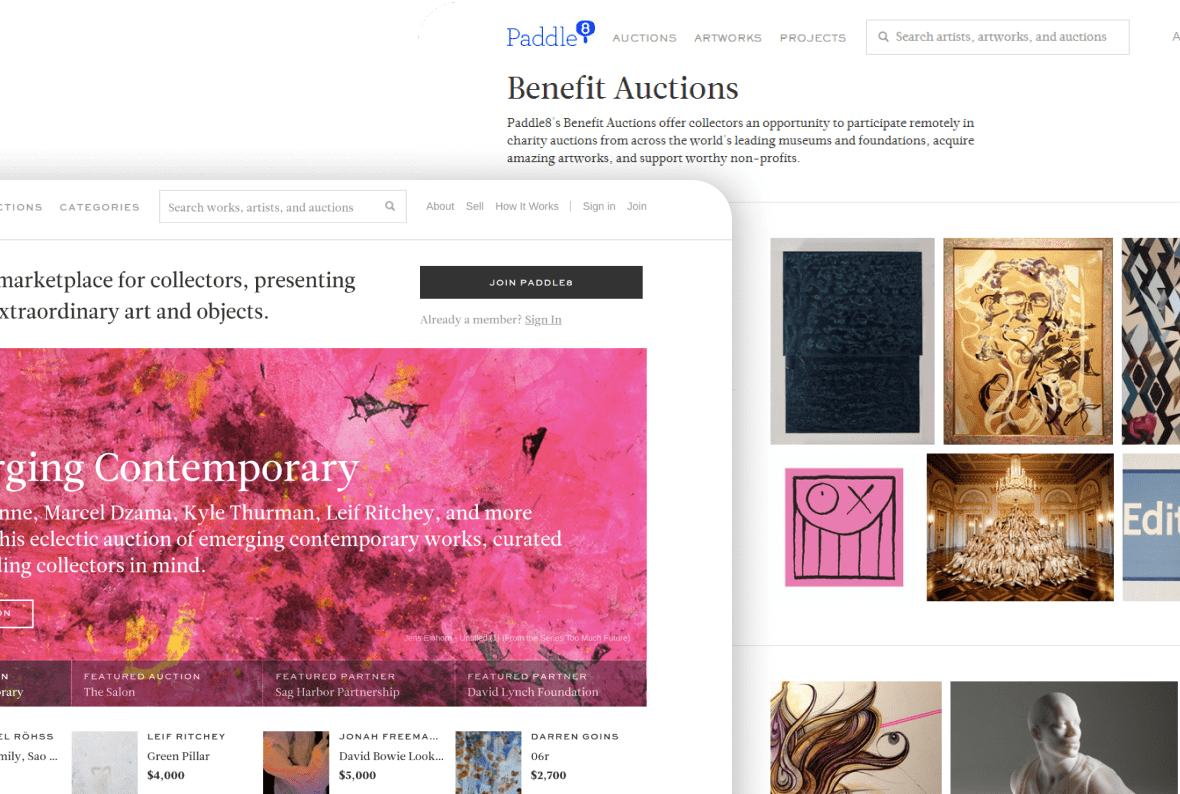Preparing for high-traffic events
Auctioning software for collectors, galleries & artists
How the Wise team, entrusted with engineering optimization, made sure the Paddle8 auction platform has efficient performance and offers a better experience for their art-loving users.Industry
Media & EntertainmentLocation
United StatesTime frame
9 monthsTech stack
Front end
React
Back end
PHP, Python, Django, GraphQL, MySQL, ELK Stack
Amazon Web Services
Elastic Load Balancing, Amazon Elastic Compute Cloud, Amazon Relational Database Service, ElasticSearch Service, Amazon S3
Google Cloud
Google Kubernetes Engine, Compute Engine, Compute Storage, Vision Artificial Intelligence
Project scope
Paddle8, a New York-based auction house, approached us with a request to prepare an auctioning software for high-load online events and improve the experience for several user personas.
Wise team’s tasks as engineering partner were to build a new admin panel for easier auction management, improve site search for collectors, create an in-house app for offline events, and optimize the overall project infrastructure.
Software audit
End-to-end app development
Mobile development
High-load system optimization
Improving UX
Background
As an online auction software for collectors, curators, and artists, Paddle8 showcased a broad range of fine art, collectibles, and luxury goods in collaboration with cultural institutions, influencers, celebrities, and more than 200 museums worldwide.
The platform could be used by collectors who were able to bid for the desired item online. It had already developed notification and alerting systems (mobile, email), as well as a tax and shipping calculation system. Auction administrators could use the platform to start, edit auctions, and generate reports on past events.
The Paddle8 team had small engineering teams in Poland and the USA and worked with freelancers for ad hoc tech tasks. Yet, for the complex technical efforts on the product roadmap, the management team decided to find a technical partner that would empower the existing teams with mature senior engineers.
Business & tech challenges
As the product started to scale, more visitors took part in the actions and more events were about to take place, the website performance began to decrease. Besides, admins needed an easier way to start auctions, and collectors – a more user-friendly way to navigate the art object catalog.
01
System unprepared for the high loads
02
Outdated legacy code
03
A slow process of adding new auctions
04
Website usability problems
Research & Project Assessment
Taking into consideration industry standards, we dived deeply into the client’s product vision and business goals. Based on our technology expertise, we offered a list of the technical environment, infrastructure, and security improvements, as well as a roadmap for the requested features – admin panel and site search.
- Conducted technical state analysis and project audit
- Prioritized project requirements
- Compiled a list of necessary services and technologies
- Created development process roadmap
- Set up communication loop with the client
Empowering the Auctioning Software
Optimized development setup
We started with moving all services from legacy unsupported Vagrant VM setup to Docker Compose. Our team took care of the code clean-up, refactoring, and supporting an old codebase within the new functionality. It allowed us to reduce the ownership cost and continue work on infrastructure optimization.
With every new feature realized, the Wise engineers also created comprehensive tech documentation and simplified the onboarding process for new teammates joining the project, both from the Wise team and teams from other countries.
Integrated site search
To help Paddle8 users find art objects on the website faster, we performed data migration and integrated the software for auction with ElasticSearch Service.
Due to code clean-up, huge parts of the legacy code were deprecated, so we also made sure all the remaining parts are compatible with the newly integrated website search.
New auction software features
We decided with the client to launch a new Bid Retraction feature because deleting a bid was a time-consuming manual process for the admins. To delete a bid, someone from the tech team had to run a SQL query in the database and perform additional testing to make sure that it didn’t affect other auctions/bids.
With the new feature, admins could delete any bids placed accidentally or that are no longer valid directly from the auction admin page. It helped Paddle8 to unburden the tech team from multiple requests and made the overall process of removing misplaced bids more secure.
Improved storefront management
Using the Paddle8 website users could both take part in the auctions or buy collectibles at a fixed price. Before collaboration with the Wise Engineering team, administrators were able to add the item to the storefront only by hard-coding images, data in the code. This was a very time-consuming and insecure process.
The Wise team helped to implement the storefront management system to the Paddle8 online auction software. Now admins could publish new artworks, add images, data, and select the page they had to be published on via the web interface.
Mobile app development
There were two mobile applications the Wise team delivered. The first one was an iOS application on React Native that basically duplicated the functionality of the website from the collector’s perspective. There was a personal user profile with a history of bidding, users could buy items at a fixed price, and place bids taking parts in the online auctions.
The second app for iPad was aimed at in-house use in offline events exclusively. The app, also written on React Native, allowed guests to place bids for the artworks that were presented during the particular offline auction.
